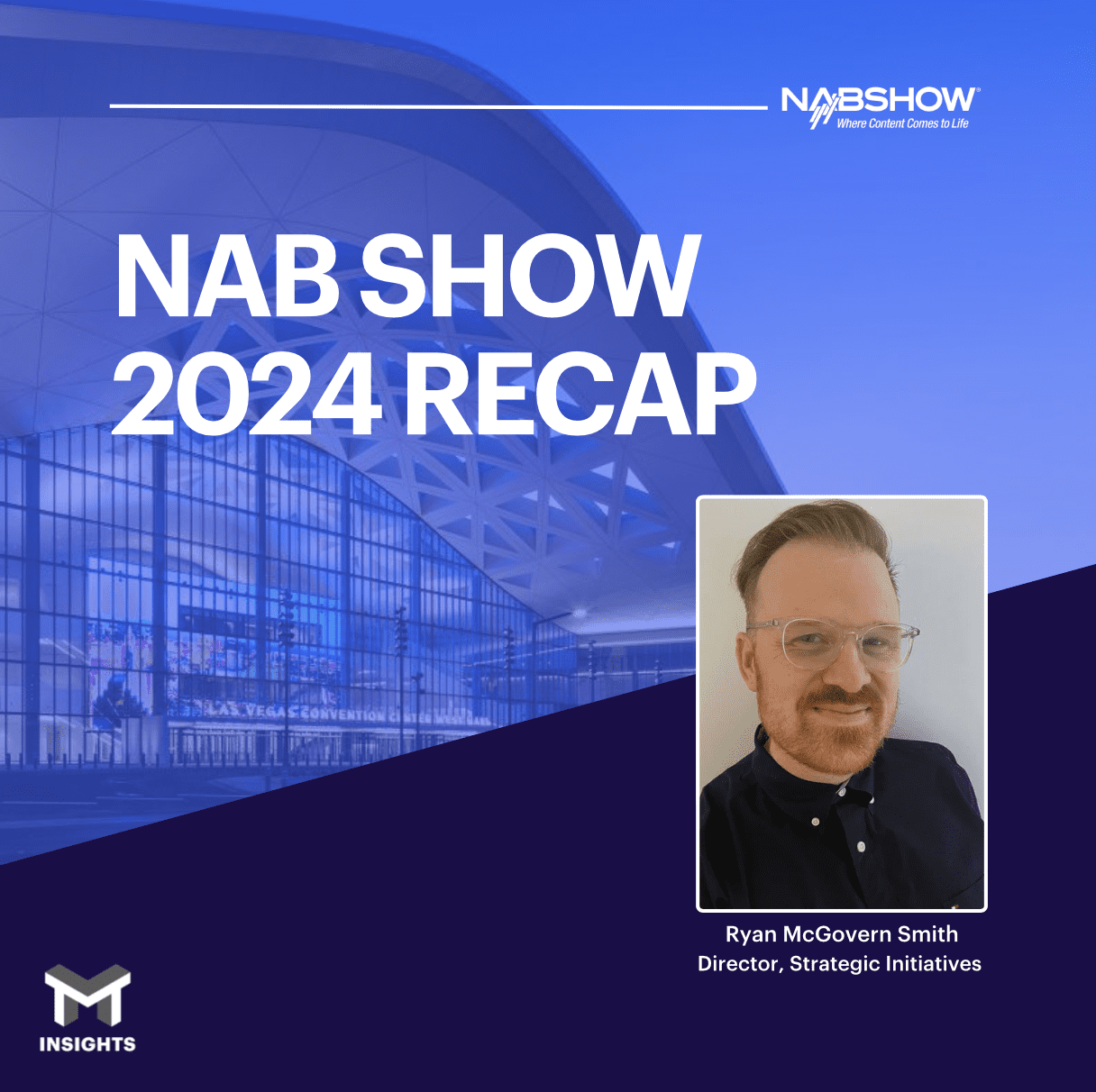NAB Show 2024 Recap

NAB Show is one of the biggest events throughout the year to attend if you’re looking to gain insights on current and emerging trends in the content distribution space. Join Ryan McGovern Smith, our Director of Strategic Initiatives, as he guides us through his takeaways from the 2024 show.
MAM in today’s marketplace
In the realm of asset management, the “dam” walls between concept and product have always been porous. Some say MAM is a verb—more something we do than something we own. Commercial off-the-shelf MAMs have always had to differentiate themselves, not only from each other, but from home-brewed solutions.
As companies continue to embrace remote workforces, the appetite to maintain proprietary on-premises systems is dwindling. With the storage piece now centralized in the cloud and the user piece federated across the globe, systems that were purpose-built on-prem by an engineering team that has since churned are rapidly reaching end-of-life.
As such, media businesses find themselves back in the MAM market. But with supply chain sensibilities now so pervasive, source-of-truth value adds are simply not enough. Customers want workflow automation, tooling that lives directly atop the tech stack, and systems that stretch further into the left/right edges of the pipeline.
Pre-qualification processes like metadata enrichment, proxy creation, and review & approve now feel standard issue. Lightweight data exchange between systems fails to impress. Consumer demand has matured. Companies require more heavy lifting and less reason to leave the platform. The MAM landscape is being seismically reshaped by industry pressures to “do more”.
The era of orchestration
Content distribution is a team effort. Final mile runners must answer for every dropped baton. Teams inherit upstream delays as their own, making up for lost time through sheer grit and long hours – a culture of prideful burnout. In this mad scramble to produce miracles, necessity breeds invention and automation flourishes.
These strands of connective tissue between tasks and systems grow over time into purpose-built “platforms”, often productized for a single business unit, held together by an unwieldy patchwork of code that is socialized through tribal knowledge and spoken traditions. Front ends are strewn atop the tangles to bring a sense of cohesion, but as technology changes and infrastructures are reshaped, the tech debt proves untenable.
Commercially available media supply chain products address this problem space by containerizing these automation concepts and stringing them together, drawing clear-cut paths through the flow. They pre-bake interactions with common media creation tools, marrying their functions to an inline web of decision trees. This modular approach allows conceptual workflow mapping to meaningfully affect the media engineering and codework pieces.
As this product category grows, we see a tension between “ease of use” and “range of control” concerns on the customer side. Dynamic development capabilities must contend with the operationalization of the tool, i.e., real world, everyday usage. How much power can be compromised to keep the lights on? Is low-code the answer, or an appetizing middle ground that can never be truly reached? Watchful hours in the DevOps product world.
AI-driven
Hype-vetting vendor marketing on the show floor is never easy. This year was made particularly challenging by the somewhat pervasive use of the phrase “AI-driven”. For one, it’s not all hype – it’s a very real thing reverberating change throughout the sector. Secondly, the word “driven” obfuscates the tech used under the hood. Is it homegrown or third party tunneled? Where does the processing actually take place? Wait… this is ML, right?
Every corner of the conference, from create to capitalize, was saturated in AI sloganeering. Some use-cases stood out to us. There were impressive examples of metadata being used to optimize customer experience. Viewership data, harvested at the edge, is fed into personalization engines that power OTT storefronts. FAST channels can be spun up and down with little to no programming. Prime time windows can now be created, not just tracked. Recommendation engines are seeing unprecedented conversion rates.
These tools dovetail into Ad-Tech and Mar-Tech (advertising / marketing technology) which have also embraced AI. With the recent boom of Ad-funded, lower cost streaming subscriptions and FAST channels, it’s no surprise that this would be an area to adopt AI. Leveraging personalization data and viewing habits, the right ads are tailored to the interests of the user based on LLMs and algorithms. The precision of the ad matching to the viewer has become almost ubiquitous with the assistance of AI.
Seemingly all of Localization is using AI (according to the show floor). From real-time subtitle generation to deep dubbing to sign language creation – globalization trends are scaling at a remarkable clip. Inclusive tech pulls in audiences in previously untapped markets which, in turn, influences the content. Not a bad thing. An amazing call-out to Signapse, using AI to auto-generate ASL/BSL avatars, performing sign language with face and torso.
Albeit still in its early stages, “AI-driven” is here to stay. Its geometric growth will continue to disrupt and revolutionize media verticals. Passed the hype lies real power, next year’s show will undoubtedly be a head turner.
